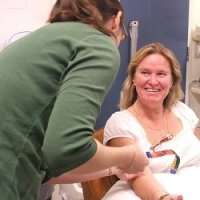Recognising monogenic diabetes is vital for its management

Distinguishing monogenic diabetes in the young – that is, a rare type of diabetes caused by a single genetic mutation relatively early in life—from other types of diabetes, is crucial for appropriate therapies, prognosis and family screening, according to research that has been published in the Medical Journal of Australia.
Professor Tim Davis and colleagues from The University of Western Australia, the Fiona Stanley Hospital in Perth, and the University of Exeter in the United Kingdom, performed a longitudinal observational study of 1668 people with diabetes in Fremantle, Western Australia.
Their data suggests that about one in 280 Australians diagnosed with diabetes has a monogenic form of the disorder; most have a European ethnic background.
"Diagnosing maturity onset diabetes in the young (MODY) and neonatal diabetes, the two main subtypes of monogenic diabetes, is important because their management (including family screening) and prognosis can differ significantly from those of types 1 and 2 diabetes," Professor Davis said.
The researchers analysed data from the Fremantle Diabetes Study Phase II for 1668 people with diabetes who were under 35 years of age. Their risk of MODY was assessed with the United Kingdom risk prediction model, which has been validated for patients with European ethnic backgrounds but is largely untested in non-European populations.
"Twelve of 148 young participants with a European ethnic background (8 per cent) were identified by the risk prediction model as likely to have MODY; four had a glucokinase gene mutation," Professor Davis said. "Thirteen of 45 from a non-European ethnic background (28 per cent) were identified as likely to have MODY, but none had a relevant mutation.
"Two patients from a European ethnic background (one likely to have MODY) had neonatal diabetes. The estimated MODY prevalence among participants with diagnosed diabetes was 0.24 per cent, an overall population prevalence of 89 cases per million; the prevalence of permanent neonatal diabetes was 0.12 per cent and the population prevalence 45 cases per million.
"The prevalence of monogenic diabetes identified by clinical risk prediction and genotyping, especially maturity-onset diabetes of the young, was relatively low in a community-based sample of Australians diagnosed with diabetes, but was higher among patients from European than those from non-European ethnic backgrounds."
In an accompanying editorial, Dr Elaine Chow and Professor Juliana Chan of the Chinese University of Hong Kong said it was "particularly challenging identifying which Asian and Indigenous Australian patients, among whom young-onset type 2 diabetes is especially common, should be screened for MODY, and there is consequently a risk of under-diagnosis".
"Research is urgently needed to characterise the families of young patients with diabetes, as well as effective methods for screening for and preventing disease," they noted.
"Understanding interactions between genetic and environmental factors is particularly important for practice, given the recognised consequences of decades of hyperglycaemia and cardio-metabolic risk factors if they are not properly diagnosed, classified, and optimally treated."
More information: Timothy ME Davis et al. The prevalence of monogenic diabetes in Australia: the Fremantle Diabetes Study Phase II, The Medical Journal of Australia (2017). DOI: 10.5694/mja16.01201



















